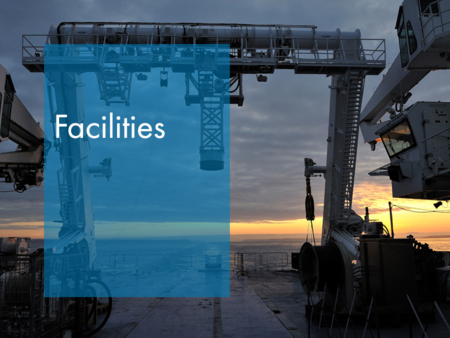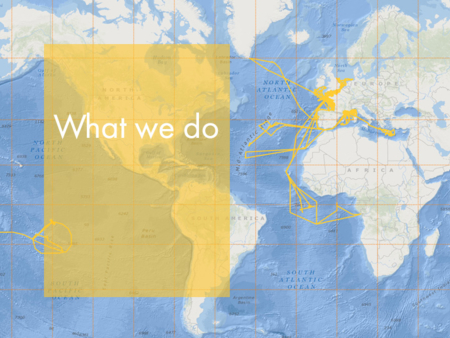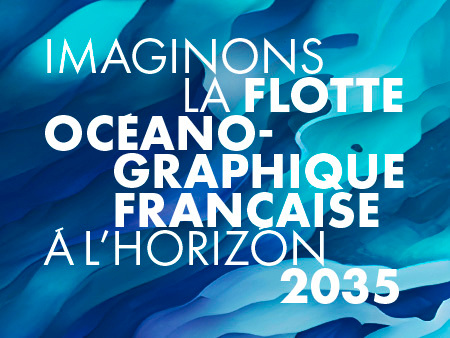Missions and organisation of the Oceanographic Fleet Management on 1st January 2018
The mission for the Oceanographic Fleet Management (DFO) is operational deployment of the fleet. It defines and implements scheduling for the French Oceanographic Fleet to serve a variety of user communities. In this capacity, it provides management of the FOF very large research infrastructure (TGIR). It oversees development and optimisation of naval resources. It steers structures overseeing the manning and equipment of all the fleet’s vessels (particularly Genavir). It coordinates for France on developing international agreements regarding oceanographic fleets. It runs its activities for the benefit of all French user communities.
For this purpose:
- It oversees the construction of fleet operations, particularly actions revolving around preparation, work permits, running campaigns and consolidation of documents at the end of a campaign. It prepares annual scheduling and associated budgeting.
- It ensures the contractual and operational interface with the different shipping lines in charge of the fleet vessels.
- It guarantees keeping the FOF in good working order and guides investments and work to be carried out.
- It prepares the Fleet Evolution Plan that it sends to the French Oceanographic Fleet TGIR steering committee.
- It runs national (TAAF, Navy, SHOM), international and European (IRSO, OFEG, CE, etc.) partnerships for the fleet and keeps up-to-date on knowledge of foreign best practices.
- It guarantees the operational quality of campaigns. It proposes and deploys developments as necessary, whilst ensuring links with user authorities that it notifies about major events that might have an impact on running the campaigns’ scientific programmes.
- It also helps make the most of research partnerships through cooperation where fleet resources are implicated (apart from research teams) or through chartering.
The oceanographic fleet management is made up of:
- the Naval Operations Centre (DFO/PON):
- the Vessels and On-board Systems unit (NSE) that is organised into two departments:
- Underwater Acoustics and Information Processing (ASTI),
- Vessel and Equipment department (NE),
- the Underwater Systems unit (SM) that is organised into three departments:
- Positioning, Robotics, Acoustics, Optics department (PRAO),
- On-board Electrical and Electronic Systems department (SEEE),
- Intervention Engineering and Mechanical Developments department (IIDM).
The management team (3 full-time employees, located in Brest) oversees the steering of the fleet management and coordinates activity of different centres and units. It guarantees meeting commitments in the fleet’s technical specification and the quality of the services provided by the TGIR. It coordinates relations with the scientific community, the management’s R&D policy and supervises national and international institutional relations. It coordinates drawing up the fleet evolution plan, and runs its deployment, plus the development and investment strategy.
The fleet director is mainly in charge of steering the management, relations with the steering committee (that he reports to) and the fleet’s institutional partnerships. The deputy director seconds and replaces the director in his/her absence and more particularly oversees the link with the scientific community. They work closely on PEF subjects and international relations, subjects on which the deputy director particularly coordinates expressing scientific needs and the link to scientific networks.
Olivier Lefort is the fleet director, Pascal Morin is the deputy director, while Nadine Rossignol is the management assistant and covers the CNFH administration department. Cécile Miossec is the corresponding DAJF for the management.
Persons subordinated to ON, NSE and SM might work on the following transverse tasks, or be given a specific mission for the corresponding portion of time, on behalf of the management:
- Overseeing the quality process.
- Administration for the technical committee / coordination of the heavy equipment plan.
- Construction of responses to chartering and DRC regarding the fleet, that can involve several DFO units.
Olivier Lefort is the director, Pascal Morin is the deputy director.
The naval operations centre (11 people) puts together naval operations conditions:
- It creates the fleet scheduling, prepares associated calls for bids and coordinates any operations with user teams or with Genavir. In this capacity, it is the interface with the commissions and the scientific teams for everything concerning operations.
- It manages the national (Navy, SHOM) and European (OFEG, ERVO) operational partnerships concerning the fleet.
- It guarantees implementation of naval resources, runs the contractual relationship with the economic interest group Genavir, the TAAF, and the CNRS and the investments linked to maintaining operational conditions.
- It coordinates technical construction of chartering bids and commercial cooperation.
Goulwen Peltier oversees the center.
The Vessels and On-board Systems unit (NSE, around 25 full time employees, located in Brest) is an engineering unit intended to cover projects the develop and modernise Ifremer vessels and their scientific equipment. It aims to maintain high performance and service levels for the infrastructure and adapt to developing needs from the user scientific community. Its missions are to:
- Run the draft projects and act as the Contracting Authority for vessel construction and modernisation;
- Carry out the definition, design (or purchase), integration, qualification, transfer and performance monitoring on the scientific and computer equipment, the telecommunication equipment and mobile scientific equipment (not including underwater systems).
Marc Nokin oversees the unit that is organised into two departments.
Underwater Acoustics and Information Processing (ASTI I) department. Partly based on R&D activity, this department has developed strong skills in the area of underwater acoustics for applications linked mainly to underwater mapping, characterisation of seabeds, fisheries and physical oceanography. It thereby develops tools and processing and quality control methodologies for the data collected by the sonar systems and new methodologies and procedures to improve on-board system performance. It is in charge of developing offset software processing tools for data, essential for sonar systems on vessels and machines. Highly involved in environmental acoustics, it defines the usage protocols for acoustic equipment and steers the subcontractor in charge of sound impact studies on the marine fauna that are required to obtain the campaign permits.
Vessel and Equipment department (NE). As Contracting Authority, this department runs the construction, modernisation and developments of the vessels, working with the scientific community and GENAVIR. On behalf of the management, it oversees steering the technical draft projects linked to the Fleet Evolution Plan. Its responsibility also includes implantation and rejuvenation of scientific and computer equipment, development of “real time” software to collect and display data, and construction of satellite telecommunication solutions for the vessels.
The Underwater Systems unit (SM, around 40 full time employees, located in Toulon) oversees developments and monitoring systems and underwater intervention, reconnaissance and surveillance methods for operational or exploratory tasks.
So, it runs projects relating to deep and shallow-water underwater systems, from when the need is expressed right up to operational commissioning, including managing subcontractors. It also provides the engineering for tools and functional interfaces or engineering on deep-water positioning devices. It helps maintain operational conditions and system development.
The unit provides its skills to support scientific campaigns, with expertise in implementation of equipment or experimental functional features, or by adapting underwater systems for specific needs. It also has underwater intervention engineering skills for installing and maintaining seabed observatories and carrying out complex operations.
It runs applied research actions to suggest ways of improving capacity or performance regarding operational underwater machines in the short/medium term, and to drive technological developments with a more consistent innovation potential in the longer term. It joins technical projects in cooperation projects and partnerships, according to relevance in the industrial and academic areas, in France and in Europe, in an attempt to widen the field of the unit’s skills and to make the most of the Institute’s skills, products and infrastructures.
In an attempt to functionally integrate underwater systems on the vessels in a coherent way, the SM and NSE units interact on the subject of bridge devices used to deploy machines and interfaces between the computer environments of machines and vessels.
Jan Opderbecke oversees the unit that is organised into two departments.
The Positioning, Robotics, Acoustics and Optics (PRAO) unit develops material and software solutions to increase machine operability and performance and the quality of the data being produced. Interest here lies in the payloads and services provided by the systems. The PRAO department combines physical sciences (optics, acoustics) with computers and robotics and is responsible for designing optical imagery systems (cameras, lighting and management of image flux) and generic image processing. It develops and maintains piloting software and on-board controller software for underwater machines.
The On-board Electrical and Electronic Systems (S3E) department covers the general techniques in Electricity, Electronics, Electrotechnical aspects and Industrial IT. The department develops sub-systems for machines used in the fleet, for new operational-based developments, and for the unit’s R&D projects. It ensures technical monitoring of systems, obsolescence management and technical documentation in key areas of energy production, power generation, electrical propulsion, lighting systems for the machines. Its field of action includes the architecture and electrical distribution of underwater systems, on-board electronics in the underwater systems and the imagery equipment.
The Intervention Engineering and Mechanical Department (2IDM) department works in all mechanical and hydraulic technical areas, particularly on the mechanical architecture of systems, structure strength, hydrostatic weighing and its associated equipment, safety and quick-release devices, actuators and servo- mechanisms and remote handling. It runs developments relating to intervention engineering particularly using methods and deployment and handling tools at sea for systems and equipment. It runs tests and equipment qualifications in environmental conditions (pressure, temperature) and also ensures this service provision on behalf of other managements and for external applicants. It manages quality on the technical files for operational underwater systems.




